For all the advantages of cloud computing, it isn't a silver bullet solution for all use cases. There are times when the bandwidth and latency limitations of the cloud are too great. As technology innovation continues, this strain is increasingly obvious. Many of the more innovative technologies sculpting our future use and produce huge amounts of data, putting operational strain on today's enterprise cloud platforms.
Edge computing can alleviate this challenge. By processing and analysing data close to the point at which it is created, businesses can get actionable insights and instructions in near-real-time. This capability is vital for technologies which demand a huge amount of computational power, and where real-time processing is absolutely crucial. For example, a driverless car needs to be able to react to data from cameras and other sensors instantly, with life or death implications. With this mind, IDC predicts over 40 per cent of organisations' cloud deployments will include edge computing by 2022.
But edge computing is no island. Tomorrow's technology relies on the co-evolution of a number of technologies to make their application a practical reality. Here we discuss how progress in edge computing and 5G are launching the success of other technologies such as IoT and wearables.
Mobile working
Mobile working has become increasingly common over the last 10 years across every industry. Your typical office worker may not require the highest level of computing power for everyday working on the move, but there are many industries where it is crucial to get maximum performance, day-in day-out. Utilities, engineering and manufacturing, logistics and healthcare among others, all have a use case for powerful, mobile applications.
5G provides the network speed and computational power to support data processing wherever it's needed. Combined with edge computing, which allows the data processing to take place locally at the device, powerful mobile computing is becoming more feasible, particularly with the recent roll out of 5G technologies across Europe.
These advances are empowering new mobile working capabilities. For example, a water treatment engineer can monitor the environmental status of a site, with important data calculations carried out in real-time, on location, and key data findings then sent to the cloud for centrally-located data scientists to analyse.
Wearable technology
The evolution of 5G and mobile edge computing technology is also providing the platform to launch enterprise wearable technologies. While wearables have been on the market for some time, their potential has been limited by the technology which supports it.
Research has found 5G was ranked by IT leaders as the factor most likely to drive uptake of smart glasses for industrial and professional applications in the coming years, bringing their use-cases closer to reality. Meanwhile, ABI Research forecasts that almost 10 per cent of industrial smart glasses and standalone Virtual Reality (VR) devices will have a 5G connection by 2026.
Smart glasses allow workers to carry out tasks hands-free, while still having access to the information and tools they need. With mobile edge computing solutions acting as the gateway, smart glasses are a natural next step to benefitting frontline and field-based workers.
For example, boiler engineers conducting an annual service could potentially use AR smart glasses to overlay the schematics of the boiler, enabling a hands-free view of service procedures - meaning that when a fault becomes a barrier to repair, the engineer is able to use collaboration software to call for assistance from a remote expert. Elsewhere, in the healthcare sector, smart eyewear may support clinicians with hands-free identification of patient records, medical procedures and information on medicines and results.
Research also shows that after one-off training sessions, employee productivity spikes but returns to its previous level after 90 days. By using wearable technology, employees can receive ongoing, on-the-job training where technicians can be mentored live, in a real-world environment, via direct video support and instructions.
We are entering an exciting wave of new capabilities. Innovations in 5G and edge computing are bringing to life technologies which have previously not reached their full potential. While wearable devices have been slow to take-off, the supporting technology - the networking and computational technology that enable it - are fast falling into place. The joint evolution of these applications means it's now possible to make smarter, faster decisions on the front-line or in the field, across many industries.
Discover more about dynabook's edge computing expertise and high-performance mobile edge computing device the dynaEdge DE-100:



















